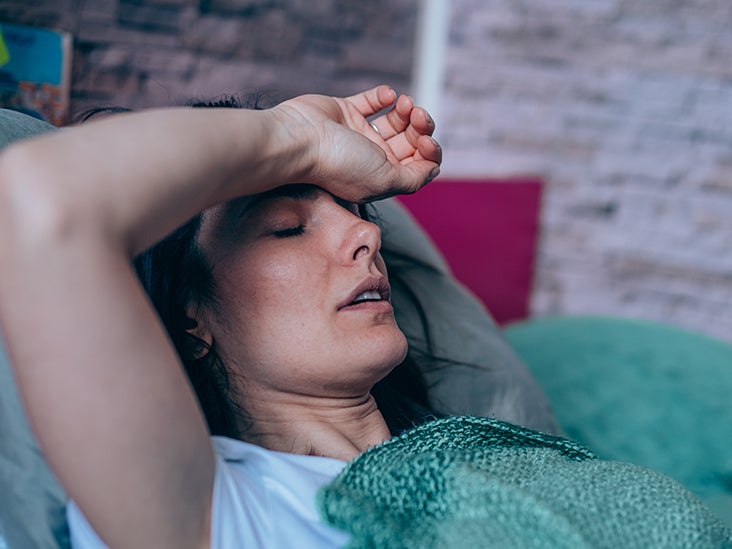Migraine Chills: How Are They Treated? - Healthline

According to the American Migraine Foundation, migraine is one of the most disabling illnesses on Earth, affecting 1 in 7 people worldwide.
Migraine episodes can cause a variety of symptoms, from light sensitivity to dizziness, and more. Some people even experience body chills. These are most likely due to changes in your brain that can happen when a migraine episode is developing.
Read on to explore the science behind migraine chills, as well as other potential causes of chills, and how to treat migraine and migraine symptoms at home.
Migraine can cause a wide range of symptoms. Many of these vary from person to person. Common symptoms during a migraine attack may include:
- throbbing or pulsing pain
- pain in different areas of the head
- lightheadedness or dizziness
- nausea or vomiting
- sensitivity to light and sound
In some people, chills can develop as a migraine symptom during any stage of a migraine episode. Chills may come on a few hours or even a few days before a migraine episode develops.
To understand how body chills may be connected to migraine episodes, it's helpful to first understand how migraine affects the brain.
According to
But how can changes in the brain related to migraine lead to symptoms like sweating, shivering, or body chills? In a
- hypothalamus
- brain stem
- cortex
Researchers think that neurological changes in these areas of the brain cause symptoms that appear during the stages before a migraine attack.
Most people experience chills or shivering when their body temperature goes down, and body temperature is controlled by the hypothalamus. One
In addition, the cerebral cortex is involved in muscle movement, and chills are the result of muscles involuntarily tightening and relaxing. Although shivering is more closely linked to activity in the hypothalamus, the cerebral cortex still plays a role in the way you perceive sensations in your body, such as chills.
Ultimately, changes within these areas of the brain can cause some people to feel chills during a migraine episode, among many other symptoms.
Migraine symptoms can be treated with a variety of different medication options, including both acute medications and prophylactic (preventive) medications.
Acute medications are helpful for relieving symptoms once a migraine attack has already started and can include:
- painkillers, which relieve pain and inflammation
- ergotamines, which contract blood vessels to relieve pain
- triptans, which contract blood vessels and change serotonin levels to relieve pain and inflammation
- opioids, which relieve pain when traditional painkillers aren't strong enough
Prophylactic medications are an essential part of migraine prevention for those with chronic migraine and may include:
- CGRP antagonists, which use antibody therapy to block certain migraine-related compounds
- beta-blockers, which block the effects of epinephrine (adrenaline) and dilate the blood vessels
- calcium channel blockers, which regulate blood vessel contraction and dilation
- antidepressants, which change neurotransmitter levels in the brain
- anticonvulsants, which calm the nerves in the brain
Generally, any medication that helps relieve your migraine symptoms — whether before an attack or during one — should also help relieve chills if you experience them.
If you experience migraine attacks or any other symptoms of migraine, such as chills, here are some home remedies to consider trying.
Home remedies for migraine
- Making dietary changes. Common dietary triggers for migraine include cured meats, chocolate, cheese and dairy, alcohol, and certain fruits, to name a few. Replacing these foods with migraine-friendly alternatives may help reduce migraine episode frequency. Adding certain foods to your diet, such as ginger and magnesium, may also help reduce migraine frequency and severity.
- Engaging in relaxing activities. Stress is a common trigger for many people with migraine, so adding stress-relieving activities to your routine is helpful for migraine prevention. Gentle workouts and activities, such as yoga and massage therapy, can help reduce daily stress levels and lower the frequency of migraine attacks.
- Considering alternative medicines. Some people have reported finding relief from migraine symptoms through alternative methods. Alternative therapies such as acupressure and aromatherapy may help manage migraine pain. In addition, certain herbal supplements, such as feverfew and butterbur, may help reduce migraine symptoms.
Home remedies for chills
Generally, home remedies are considered the first line of treatment for chills that do not accompany a serious condition. However, you may find that certain treatments work better than others, depending on the underlying cause.
If chills commonly accompany your migraine episodes, treating the underlying migraine should help reduce or even eliminate this symptom. If your chills and headaches have another underlying cause, such as a viral infection or medication use, sometimes over-the-counter or prescription medications can help temporarily relieve symptoms.
However, if you have been experiencing chills that do not go away with home treatments or become worse over time, contact a healthcare professional for further testing.
Migraine episodes can come with a wide variety of symptoms, including chills. Many of these symptoms can be debilitating for people living with migraine.
In some cases, chills can be caused by changes in the brain that happen before or during a migraine attack. In other cases, chills that accompany a headache may indicate a more serious underlying condition.
If you are concerned that your chills may be more than just a symptom of your migraine episodes, reach out to a healthcare professional as soon as possible to discuss your concerns.


Comments
Post a Comment